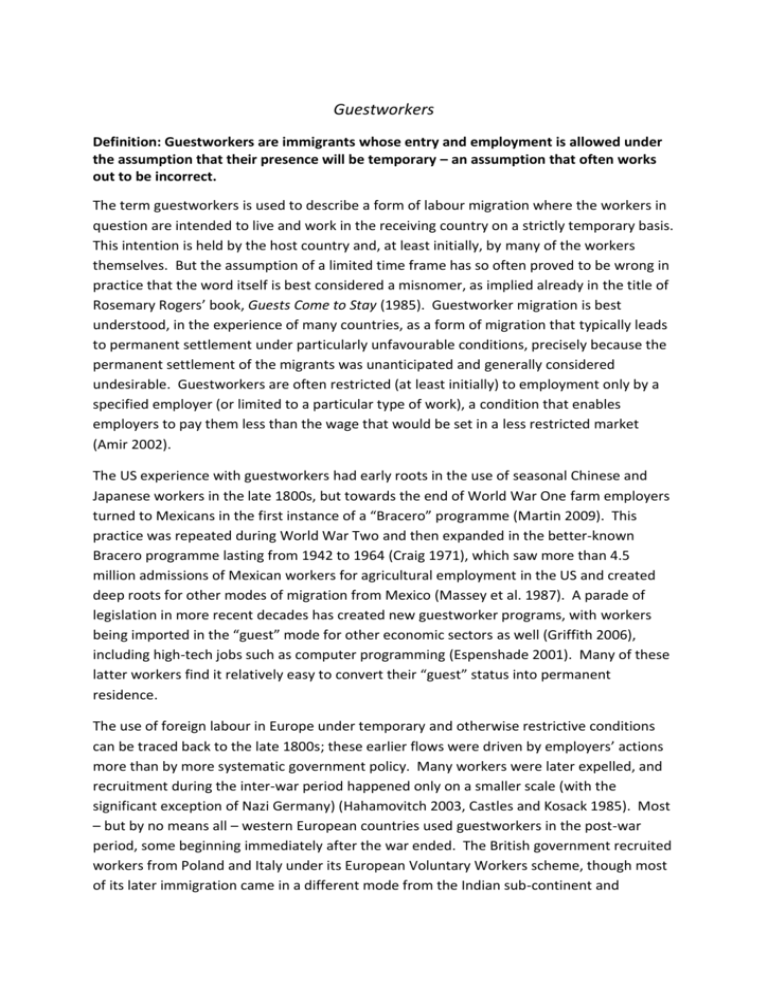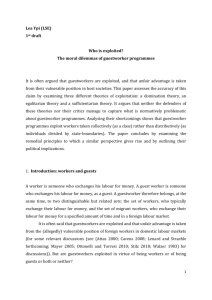Guestworkers
advertisement

Guestworkers Definition: Guestworkers are immigrants whose entry and employment is allowed under the assumption that their presence will be temporary – an assumption that often works out to be incorrect. The term guestworkers is used to describe a form of labour migration where the workers in question are intended to live and work in the receiving country on a strictly temporary basis. This intention is held by the host country and, at least initially, by many of the workers themselves. But the assumption of a limited time frame has so often proved to be wrong in practice that the word itself is best considered a misnomer, as implied already in the title of Rosemary Rogers’ book, Guests Come to Stay (1985). Guestworker migration is best understood, in the experience of many countries, as a form of migration that typically leads to permanent settlement under particularly unfavourable conditions, precisely because the permanent settlement of the migrants was unanticipated and generally considered undesirable. Guestworkers are often restricted (at least initially) to employment only by a specified employer (or limited to a particular type of work), a condition that enables employers to pay them less than the wage that would be set in a less restricted market (Amir 2002). The US experience with guestworkers had early roots in the use of seasonal Chinese and Japanese workers in the late 1800s, but towards the end of World War One farm employers turned to Mexicans in the first instance of a “Bracero” programme (Martin 2009). This practice was repeated during World War Two and then expanded in the better-known Bracero programme lasting from 1942 to 1964 (Craig 1971), which saw more than 4.5 million admissions of Mexican workers for agricultural employment in the US and created deep roots for other modes of migration from Mexico (Massey et al. 1987). A parade of legislation in more recent decades has created new guestworker programs, with workers being imported in the “guest” mode for other economic sectors as well (Griffith 2006), including high-tech jobs such as computer programming (Espenshade 2001). Many of these latter workers find it relatively easy to convert their “guest” status into permanent residence. The use of foreign labour in Europe under temporary and otherwise restrictive conditions can be traced back to the late 1800s; these earlier flows were driven by employers’ actions more than by more systematic government policy. Many workers were later expelled, and recruitment during the inter-war period happened only on a smaller scale (with the significant exception of Nazi Germany) (Hahamovitch 2003, Castles and Kosack 1985). Most – but by no means all – western European countries used guestworkers in the post-war period, some beginning immediately after the war ended. The British government recruited workers from Poland and Italy under its European Voluntary Workers scheme, though most of its later immigration came in a different mode from the Indian sub-continent and elsewhere in the Commonwealth (Kay and Miles 1992). France and the Netherlands recruited workers from elsewhere in Europe but also drew immigrants from their own colonies. West Germany again made extensive use of guestworkers beginning in the late 1950s, bringing Turkish and Italian workers to address labour shortages in specific sectors such as automobile manufacture (Herbert 1980). As in the US, in most cases the official recruitment programmes were accompanied by inflows of workers in other modes, including use of tourist visas to gain entry followed by irregular employment (Castles, Booth and Wallace 1984). By 1973, with the first OPEC oil crisis, there was widespread awareness in Europe that the alleged merits of guestworker migration depended on assumptions that were quite simply wrong in many cases (Miller and Martin 1982). Workers were initially given visas with limited validity, under a principle of “rotation”: it was considered important to send them home before they put down roots, and then to replace them with new workers. But some of the migrants put down roots more quickly than anticipated, and their employers discovered they had no particular reason to favour losing employees who knew their work, and then replace them with people who didn’t. Governments then discovered that deportations were more difficult and more costly than they had imagined. With the recession following the oil crisis, most wealthy countries no longer recruited guestworkers. But many existing workers stayed and became permanent immigrants (though many also left), eventually with the right of permanent residence (Rogers 1985). Having gained a degree of permanent status, some then exercised a widely accepted right of family reunification. As the majority of guestworkers had been men, family reunification typically meant bringing wives (and children), in some cases via arranged marriages subsequent to migration. As noted at the outset, however, these “new” permanent immigrants had not initially been conceived as such, and in some countries adjustment to their permanence has been very slow, and indeed remains unresolved in the present. Particularly in “ethno-nationalist” countries such as Germany, which for many years followed strictly a jus sanguinis model of citizenship (passed through familial descent), the idea that workers from elsewhere could become German was simply not plausible. Conditions for naturalization were very restrictive; large proportions of the second and even third generations continued to be excluded from German citizenship, despite speaking German as a first language and (at least for some) never even visiting their “home” country (e.g. Turkey). Guestworker migration, then, was in the end a mechanism for creating a set of excluded ethnic minorities in countries that had been (at least in their imaginations) homogenous (Martin and Miller 1980). As people in these groups became permanent residents with greater rights and a stronger sense of membership in the local setting, they typically became less willing to play the economic roles they had initially been recruited for: they came to shun low-status work and wanted employment security just as other local workers did (Piore 1979). Permanent settlement, then, helped to re-create some of the labour shortages that had initially led employers and policy makers to recruit workers abroad, leading Martin and Miller to conclude (1980) that dependence on guestworkers had become self-sustaining. Despite being the subject of an “obituary” in the 1980s (Castles 1986), the guestworker idea continues to attract policy makers in wealthy countries (Castles 2006, Martin 2009). Some politicians and others persist in believing that it will be possible to bring workers without bringing people (to paraphrase Max Frisch’s well-worn aphorism, 1967). Israel in the mid1990s imported large numbers (relative to the population, i.e., percentages) of workers from places such as Romania, Thailand, and the Philippines, despite the pleas of people who knew well what had happened in Europe and who feared that the consequences for Israel would be even more difficult (Bartram 2005). Germany in the 1990s resuscitated its own guestworker programs (Martin 2004). And the American government in 2011 was contemplating a new guestworker programme, as part of a package of measures designed to address the very large population of undocumented immigrants. In countries lacking a strong commitment to principles of democracy and human rights, guestworker programs were not as dysfunctional in the ways described here (though surely more dysfunctional in others). Countries such as Singapore and Saudi Arabia have been more able and willing to enforce time restrictions and other limitations on workers’ rights; some countries (e.g. Libya and Nigeria) have deported workers en masse. The guestworker dilemma is, to a certain extent, a problem specifically for democratic countries, though even in places like Kuwait the use of guestworkers has social and political dimensions and is not a solely economic phenomenon (Birks et al. 1986). Another notable recent trend is the “feminization” of guestworker programmes, sometimes dubbed the “Maid Trade” (e.g. Chin 1998). The discussion above paints guestworker migration in a particularly negative light. But some scholars see it differently. Whether guestworker migration is a good idea is a question that can’t be answered properly in the abstract; instead, it has to be considered in comparison to available alternatives. One alternative is that workers who might merely be “guests” would be able to enter under more favourable conditions, perhaps even freely, right from the outset. But that alternative is not actually available in most destination countries, mainly for political reasons. Another alternative, then, is that, instead of being admitted as guestworkers, prospective migrants might not be admitted to wealthy countries at all. Having framed the question in those terms, some writers assert that it is ethically preferable (when considering the interests of immigrants, at any rate) to allow guestworker migration over not allowing immigration at all (Ruhs and Chang 2004). People might choose to accept the restricted rights associated with guestworker status, simply because the benefits associated with gaining extra income outweigh the costs of the restrictions on rights (in particular, prospects for settlement). (Amir 2002) (Bartram 2005) (Birks, Seccombe, and Sinclair 1986) (Castles 1986) (Castles 2006) (Castles, Booth, and Wallace 1984) (Castles and Kosack 1985) (Chin 1998) (Craig 1971) (Espenshade 2001) (Frisch 1967) (Griffith 2006) (Hahamovitch 2003) (Herbert 1990) (Kay and Miles 1992) (Martin 2009) (Martin and Miller 1980) (Massey, Alarcón, Durand, and González 1987) (Piore 1979) (Rogers 1985) (Ruhs and Chang 2004) References Amir, Shmuel (2002) 'Overseas foreign workers in Israel: policy aims and labor market outcomes', International Migration Review 36: 41-57. Bartram, David (2005) International labor migration: foreign workers and public policy, New York: Palgrave Macmillan. Birks, J. S., Seccombe, I. J. and Sinclair, C. A. (1986) 'Migrant Workers in the Arab Gulf: The Impact of Declining Oil Revenues', International Migration Review 20: 799-814. Castles, Stephen (1986) 'The guest-worker in Europe: an obituary', International Migration Review 20: 761-78. Castles, Stephen (2006) 'Guestworkers in Europe: A Resurrection?', International Migration Review 40: 741-66. Castles, Stephen, Booth, Heather and Wallace, Tina (1984) Here for good: Western Europe's new ethnic minorities, London: Pluto Press. Castles, Stephen and Kosack, Godula (1985) Immigrant workers and class structure in Western Europe, Oxford: Oxford University Press. Chin, Christine B.N. (1998) In service and servitude: foreign female domestic workers and the Malaysian "modernity" project, New York: Columbia University Press. Craig, Richard B. (1971) The Bracero program: interest groups and foreign policy, Austin: University of Texas Press. Espenshade, Thomas J. (2001) 'High-end immigrants and the shortage of skilled labor', Population Research and Policy Review 20: 135-41. Frisch, Max (1967) Öffentlichkeit als Partner, Frankfurt am Main: Suhrkamp. Griffith, David (2006) American Guestworkers: Jamaicans and Mexicans in the U.S. Labor Market, State College, PA: Pennsylvania State University Press. Hahamovitch, Cindy (2003) 'Creating Perfect Immigrants: Guestworkers of the World in Historical Perspective', Labor History 44: 69 - 94. Herbert, Ulrich (1990) A history of foreign labor in Germany, 1880-1980: seasonal workers, forced laborers, guest workers, Ann Arbor: University of Michigan Press. Kay, Diana and Miles, Robert (1992) Refugees or migrant workers?: European volunteer workers in Britain, 1946-1951, London: Routledge. Martin, Philip L. (2009) Importing poverty? Immigration and the changing face of rural America, New Haven: Yale University Press. Martin, Philip L. and Miller, Mark J. (1980) 'Guestworkers: lessons from Western Europe', Industrial and Labor Relations Review 33: 315-30. Massey, Douglas S., Alarcón, Rafael, Durand, Jorge and González, Humberto (1987) Return to Aztlan: the social process of international migration from western Mexico, Berkeley: University of California Press. Piore, Michael J. (1979) Birds of passage: migrant labor and industrial societies, Cambridge: Cambridge University Press. Rogers, Rosemarie (1985) Guests come to stay: the effects of European labor migration on sending and receiving countries, Boulder: Westview Press. Ruhs, Martin and Chang, Ha-Joon (2004) 'The ethics of labor immigration policy', International Organization 58: 69-102.







